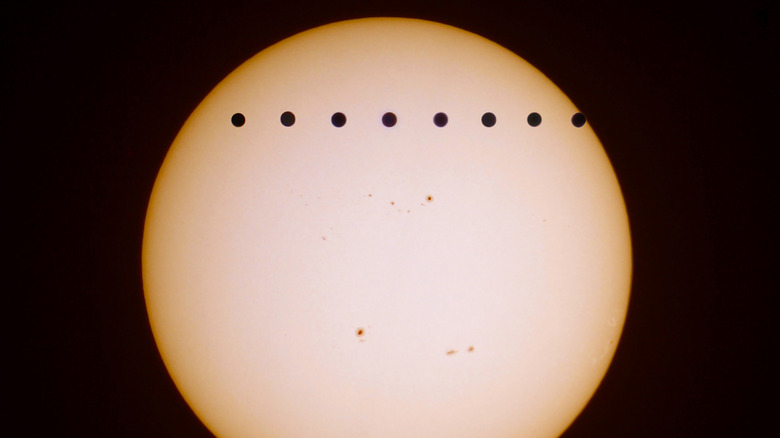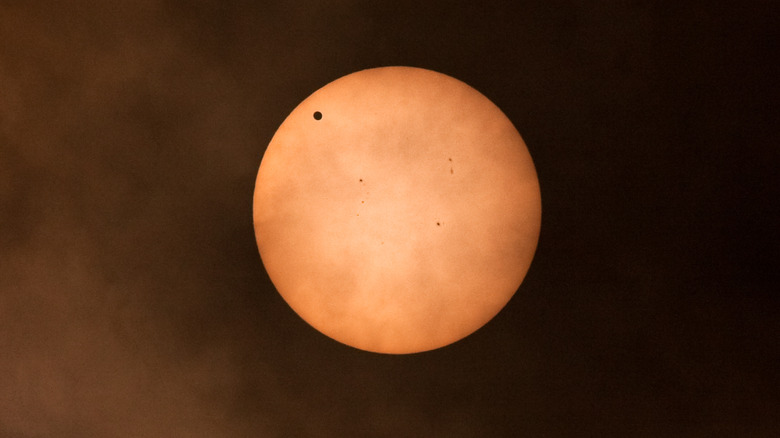How Two British Astronomers Documented The First Transit Of Venus In 1639
In 1639, the field of astronomy was still in a phase of star mapping and discovering the laws that governed the solar system and universe. On the day of November 24, a revolutionary stride occurred — the first observation of the transit of Venus. Johannes Kepler had already been deceased for nine years when the observation was made, but his studies laid the groundwork for the efforts of two British astronomers, Jeremiah Horrocks and William Crabtree (via Oxford Academic). Kepler defined laws of planetary motion and published a catalog called the Rudolphine Tables, which described over 1,000 stars and had directions for locating planets, per Britannica.
Many innovations and new theories occurred in astronomy during the 1600s, notably the progression of the telescope by Galileo Galilei in 1609 (via Britannica). In concert with Kepler's laws of planetary motion, these new tools and ideas for understanding the heavens helped the pair of astronomers galvanize the field into a new era that emphasized direct observation of planetary phenomena.
Jeremiah Horrocks' and William Crabtree's history
Jeremiah Horrocks and William Crabtree had similar backgrounds. Both were above common peasantry, but they were not men of wealth. They were yeoman farmers and merchants who were not university-trained. Crabtree hailed from Broughton, and then Lancashire, England, and Horrocks was also from Lancashire. By 1636, both men were completely self-taught in the field of astronomy defined by the work of Kepler and Galileo (via Oxford Academic).
Crabtree, who was older than Horrocks by about nine years, had studied astronomy for several years before meeting Horrocks near Manchester, and they soon corresponded extensively about the developing discipline (via Encyclopedia). The pair questioned why tables were often inaccurate when it came to predicting eclipses precisely. Although the work of their predecessors was instrumental, Horrocks and Crabtree believed that astronomical realities could not be discerned entirely through the abstract computations of previous astronomers. Instead, the astronomy they believed in would involve direct observation and analysis.
The documentation of the transit of Venus
Although the older astronomers were being supplanted by a new generation, Jeremiah Horrocks and William Crabtree used a method for observing eclipses that was posited by Kepler. The method was modified for the telescope by an astronomer named Pierre Gassendi and intended for Kepler's observation of Mercury's transit in 1631. Sunlight passed through a telescope into a dark room, which allowed the sun's disk to be copied onto a small white screen. According to Encyclopedia, the screen was divided into 120 parts along the sun's diameter and by degrees at the circumference.
Crabtree was not with Horrocks at the time of the transit. He observed the phenomenon from the outskirts of Manchester and saw it for only a short time. He was unable to record accurate data during the viewing, but his observations turned out to align with those of Horrocks. In consequence, his friend was better remembered in the annals of astronomy, and his analysis of the transit of Venus allowed him to improve upon earlier understandings of the planet (via Encyclopedia). Observations of the transit of Venus occurred years later in 1761, 1769, 1874, and 1882, with the latter two becoming popular among the general public in addition to astronomers. The last transit occurred June 5-6, 2012, and it was the last transit of the 21st century, per The Atlantic.


